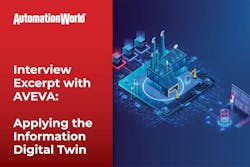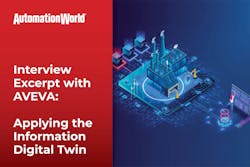Quick hits:
- Information Digital Twins address how people across still struggle to find the information they need to make timely and informed decisions, and be able to answer why assets still fail and why customer commitments are not always met.
- Information Digital Twins take all data about industrial assets—the design information, the operations information, the commissioning information, the asset management and financial information—and fuse this together into an information data model that links back to the physical asset itself.
- How Dominion Energy uses the Aveva PI System and Aveva Data Hub to collect operational data from its assets, archive this information, compress it, and then organize it through an asset information model that allows all this information to be contextualized so that it's consumable by all the applications and users of the technology.
Related to this episode:
- Listen to the full podcast: How Does an Information Digital Twin Democratize Industrial Data?
- Read the in-depth article: The Transformational Impact of an Information Digital Twin
Information Digital Twin section
Automation World - David Greenfield:
We've all heard about the digital twin by now. But this idea of the information digital twin seems to be a new concept. Can you explain what an information digital twin is, how it's created, and what it's used for?
Aveva - Sean Gregerson:
Today, we still have in our businesses this disconnected environment where we have these siloed functional islands in our business of data connectivity silos and communication silos, and divisional and stakeholder silos across Engineering and Operations and Maintenance and in all the different domains of our businesses and systems are still not always connected. And people still really struggle to find the information they need to make timely informed and inaccurate decisions and assets are still fail and customer commitments are not always met. In we have loss of profits and safety incidents. And this information digital twin is really a way to solve a lot of these problems. In the way you construct the information digital twin is to take all the information that you have about your industrial assets today, the design information, the operations information, the commissioning information, the asset management and financial information, and fuse this together into this information data model. And then link that information data model back to the physical asset itself in 3d and in the context of its connectivity within the plants are more informed, more timely, more accurate decisions can be made.
Dominion Energy section
Automation World - David Greenfield:
Given your experience with working with different industrial companies in different verticals, can you share an example of a company that's using the connected industrial economy as you described it, and how its benefited their operations?
Aveva - Sean Gregerson:
Yeah, sure, I think a good example would be Dominion Energy, where they're going through a transformation of their business where they're transforming their generation assets and adding more and more renewables to that. And as part of that, they've really developed a new service for their customers, both their residential and industrial customers, were, they're leveraging this connected industrial economy, to be able to so that their customers can understand how their energy is being sourced, and they can understand better their energy consumption patterns, so that they can really make better decisions for their families and their businesses. And the way that, that they did this, is they did this using the Aveva PI System at the edge to collect all of this operational data from these renewable assets. And this PI system takes it and archives this information, high fidelity, second by second, compresses it, and then organizes it through this asset information model, this asset framework that allows all this information to be organized and contextualized in a way that it's consumable by all the applications and all the users of the technology. And it's it's very understandable because the the information has been contextualized at that source level, what this information is and how it can be used to make better decisions across the business. And the next layer of that is really the analytics layer their self service analytics so they can go and build any KPIs or any analytics that can better drive more have informed timely decisions across the business. And then moving up to that next layer of event management where they can go in and create any events that when this condition exists, I want to notify by email or text, this group of people, or maybe I want to auto trigger a work order in the enterprise asset management system, based on that condition to automate and close the loop on that asset management workflow. And then at that top layer, this rich visualization layer that brings all this information and puts it in the context of the consumer of the information and their role within the business. And all of those applications, then leveraging this data model, so that I can build things out from a data model perspective. And all the the calculations associated maybe with that asset class, or the events with that asset class are the visualization screens for that type of asset, automatically update as I add new assets to my system, so incredibly powerful and scalable across the business. And then what they have done is leverage the Aveva Data Hub technology, which takes this information from the ads securely, transports it to the cloud, where the data is further contextualized. And then made available to dominions, customers in a very secure way and on a selective basis. And as part of that, the information’s there. So on a selective basis, they can now make that information available to their ecosystem of partners and suppliers and OEMs, that can then take that information and translate it back into some value proposition for Dominion Energy.
Leaders relevant to this content:






